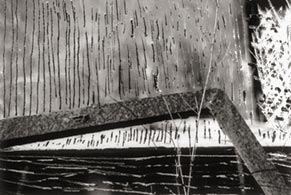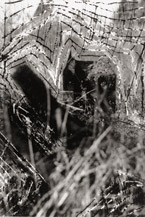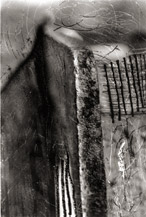|
EMULSION ENGRAVINGS
by Péter HERENDI
The 1990s have been characterised by revised approaches to photography
and by a certain expansion. Archaic techniques, as well as APS format
and digital techniques, are becoming morewidespread, but alongside these,
the main aesthetic feature of photographic
pictures is the spread of factural and installation procedures. The
rotting, hammering, scratching, damaging and physical violation
of the emulsion, or the use of polaroid transfers as printing plates,
are phenomena aimed at the creation of an intensive event horizon
of the pictorial operations and surfaces, thus broadening the experiential
and sensual realm of photography and transcending the sterile methods
employed in the traditional laboratory treatment of material.
The pictorial facture of the layers of photographic material has its
origins more than forty years ago with the embracing of graininess,
followed by the recognition of the perforated negative, as active elements
in the creation of the picture. The "accidental" processes
of facture have re-emerged with the revival of archaic techniques, as
intentional "mistakes" in the emulsion-covered glass negatives.
However, as clearly shown in Péter Herendi’s work, scratching,
smearing and abrasion (all recognised graphical techniques), and physical
intervention in processes and materials, are applied consciously and
reflect an intention to shape the photographic horizon beyond the photograph.
This concept requires the construction of a hierarchy of creative concepts
and manipulative photographic stratagems. These quasi-graphical operations
(Herendi has always regarded himself as a fine artist) result in the
re-composition of the photographically fixed pictorial layers, which
are expanded using crude, mechanically imprinted information. The highlighting,
and the intellectual and physical redrawing, of signs, forms and spatial
planes and layers, creates a new compositional layer in the picture.
"On top of" the layer of material and light processes, the
picture is given a scratched and crushed "foil" of manipulative
and aesthetic operations. What results is a layered archaic field of
signs: beneath is the work of the most ancient and elemental gesture,
the result of natural energies; above is the horizon of the interpretative
aggression. Such a work is a picture of the arche, the origin, and of
reaching backwards, a tectonic upheaval and the exposure of ancient
unveiled processes. Péter Herendi’s series evokes the consistency
between techne and arche. Obviously these pictures are not intended
to look ancient; however, their relationship to the material processes
is ancient and "elemental", as are the exposed pictorial signs
which the artist attempts to "read" in them and steal from
them with his grating chisel.
Translateed by Rachel and János HIDEG
|
HERENDI Péter
KARCOLATOK
A ‘90-es éveket a fotográfia szemléleti megújulása,
egyfajta expanziója jellemzi. Tért hódítanak
az archaikus technikák, velük egyi dôben az APS formátum,
valamint a digitális fotográfia – de mindezek mellett
a fotografikus képek legfôbb esztétikai jellemzôje
a fakturális és installációs mûveletek
elterjedése. Az emulzió rothasztása, kalapálása,
karcolása, felsértése, fizikai meggyötrése,
a polaroid transzferek nyomatként használása stb.,
mind olyan jelenség, amely a képi mûveletek és
felületek intenzív eseményhorizontjának megalkotását
célozza. Ezzel is tágítva a fotográfia tapasztalati
és érzéki tartományát, egyuttal túllépve
a hagyományos laboratóriumi anyagkezelés steril
fogásain.
A fotografikus anyagrétegek képfakturája a szemszézettség
vállalásával kezdôdött immár
több mint négy évtizede, majd filmnegativ perforációjának
képalkotó elemként megjelenése követte.
A faktura ‘véletlenszerû’ anyagfolyamatai az
archaikus technikák feledésével bukkantak ismét
elô, az emulzióöntéses üvegnegativok szándékos
‘hibáiként’. De mint Herendi Péter képein
is nyilvánvaló, a karcolás, horzsolás, dörzsölés
/ mind ismert grafikai technika / a fizikai beavatkozás az anyagfolyamatokba,
itt már nem tudatos formát öltött és
a fotografikus képsik fotón túli kialakitásának
szándékát jelzi. Ez a képfelfogás
az alkotói, szerzôi elgondolás és a manipulációs
fogások szoros egymásraápülását
kivánja meg. A kvázi grafikai mûveletek / Herendi
Péter mindig képzômûvésznek tartotta
magát / fotografikusan rögzitett képrétegek
átkomponálását eredményezik illetve
ezek bôvitését egyfajta durva, mechanikai bevésett
információival. A jelek, formák illetve a térsikok
és a rétegek kiemelése, intrellektuális
és fizikai átrajzolása a képnek egy újabb,
kompozitorikus rétegét hozza létre. A kép
az anyag és fényfolyamatok rétege fölé
a manipulációs és esztétikai mûveletek
zúzott, karcolt fóliáját ölti magára.
Egy rétegezett archaikus jelmezôt kapunk igy: ami legalul
van , az a legôsibb legelemibb gesztus mûve, igy a természet
alakitó energiájának eredménye: ami efölé
kerül, az pedig az pedig az értelmezô erôszak
horizontja. Arché, az eredet, a visszanyúlás képe
az ilyen mû. Ôsi, csupasz folyamatok tektonikus egymásra
torlódása és feltárulása. Herendi
Péter sorozata a techné és az arché konzisztenciáját
idézi fel. Nyilvánvalóan ezek a képek nem
akarnak ôseinek mutatkozni, de ôsi elemi,az anyag-folyamatokba
való viszonyuk, és azok felszinre bukkanó képjelek
is, amiket csikorgó vésôjével a mûvész
‘ kiolvasni’ és ellopni igyekszik belôlük.
Szûcs Károly
99’ október 13.
|













